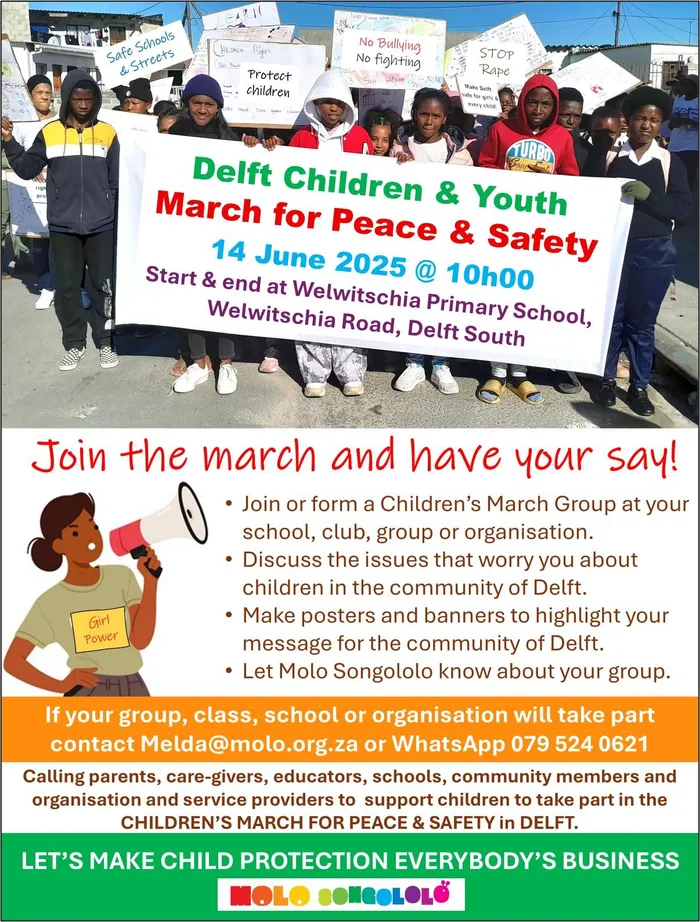
Children as young as 12 are being sucked into the deadly vortex of gang violence in the Western Cape, while hospitalisation for gunshot and stab wounds remain high.
Image: Supplied
IN JUST over a year, more than 700 children were admitted to hospital for gunshot wounds while over 3800 were hospitalised for stabbings in the province.
As Child Protection Week draws to a close, activists highlighted that little progress has been made to ensure children are not subjected to abuse and violence.
Meanwhile, children as young as 12 were also being sucked into the deadly vortex of gang violence used as decoys, gunmen, and drug couriers according to the latest Western Cape Gang Monitor by the Global Initiative Against Transnational Organised Crime (GI-TOC).
The report also found that more than one child was murdered every day in the Western Cape over a three-month period in 2024.
The spike is linked directly to gang violence, where children are either caught in crossfire or recruited into the gangs themselves.
“This sobering statistic is indicative of a wider trend: more children than ever before are being recruited into gangs in the Western Cape,” the report states.
Children are seen as ideal recruits by gang leaders, less likely to be suspected by police, and more willing to prove themselves.
Craven Engel, a pastor and founder of gang-prevention organisation Ceasefire, told the report that gangs are weaponising innocence; “a 12-year-old boy he had assisted, who had been recruited as a gunman for the Only the Family gang, was ‘brainwashed to kill people.’”
The report highlights a toxic combination of factors: poverty, generational trauma, and community breakdowns contributing to the vulnerability of children, to gangs.
Community workers say that “these kids are totally desensitised to violence. When they play games in the street, they have to play around a dead body.” The problem is compounded by gang fragmentation.
Newly formed junior gangs, such as the Gotsavallas in Ottery, have emerged with younger and more reckless members.
“The group is made up exclusively of juvenile members, none of whom is older than 18,” the report states.
Juvenile detention is no deterrent. Instead, it is described as a graduation into the gang, where “young offenders may enter as a runner, but on leaving, may join the ranks outside as a fully-fledged member.”
The provincial health department said the number of children admitted for gunshot wounds (718) and stabbings (3 864) from January 1, 2024 to May 31, 2025, was lower than other causes.
Provincial health spokesperson, Shimoney Regter said the number includes hospital admissions due to various injuries from 75 Hospital and Emergency Centre Tracking Information System linked healthcare facilities in the province.
“In instances where a healthcare worker suspects that a child’s injury may be linked to abuse or violence, there are clear procedures in place and support is provided to children and their families," she said.
Child rights organisation Molo Songololo said children experience physical and non-physical trauma in their homes, at school and in their communities.
“Contributing factors for the high incidents of violence and crimes committed against children in hot spot areas identified in the recent SAPS stats includes poverty, and poverty related factors, unemployment, lack of jobs, lack of income and food insecurity, lack of and poor access to basic support services, poor infrastructure and sanitation, denial of support services, poor educational outcomes, substance abuse and addictions, robberies, extortions and gang related violence, early sexual activity and parenthood, and abusive, violence and exploitative sexual behaviour and practices; and the acceptance and normalisation of abuse, violence and crime; and child abandonment and absent fathers; including racial and social conflicts.
“More and more people, young people and even children are turning to criminal activity as a means of survival. This has caused a spike in theft, robberies, exploitative practices, and trafficking in children and adults,” said Molo Songololo director, Patric Solomons.
He added that child protection must be everybody’s business "every day everywhere".
Solomons added that learner support services were also needed to keep children in school and reduce school drop-out rates.
Molo Songololo will on June 14 host the Delft Children March for Peace and Safety in Delft South, which will start and end at Welwitschia Primary School. The march aims to mobilise the community through child participation to improve peace and safety for children in Delft.
The march is open to parents, schools, educators, community members and organisations to join. To get involved, contact melda@molo.org.za or WhatsApp 079 524 0621.
Cape Times

Government and community service providers will also take part in the Delft Children March for Peace and Safety on Saturday 14 June in Delft South, which start and end at Welwitschia Primary School. The children’s march aims to mobilise the community through child participation to improve peace and safety for children in Delft.
Image: Supplied
